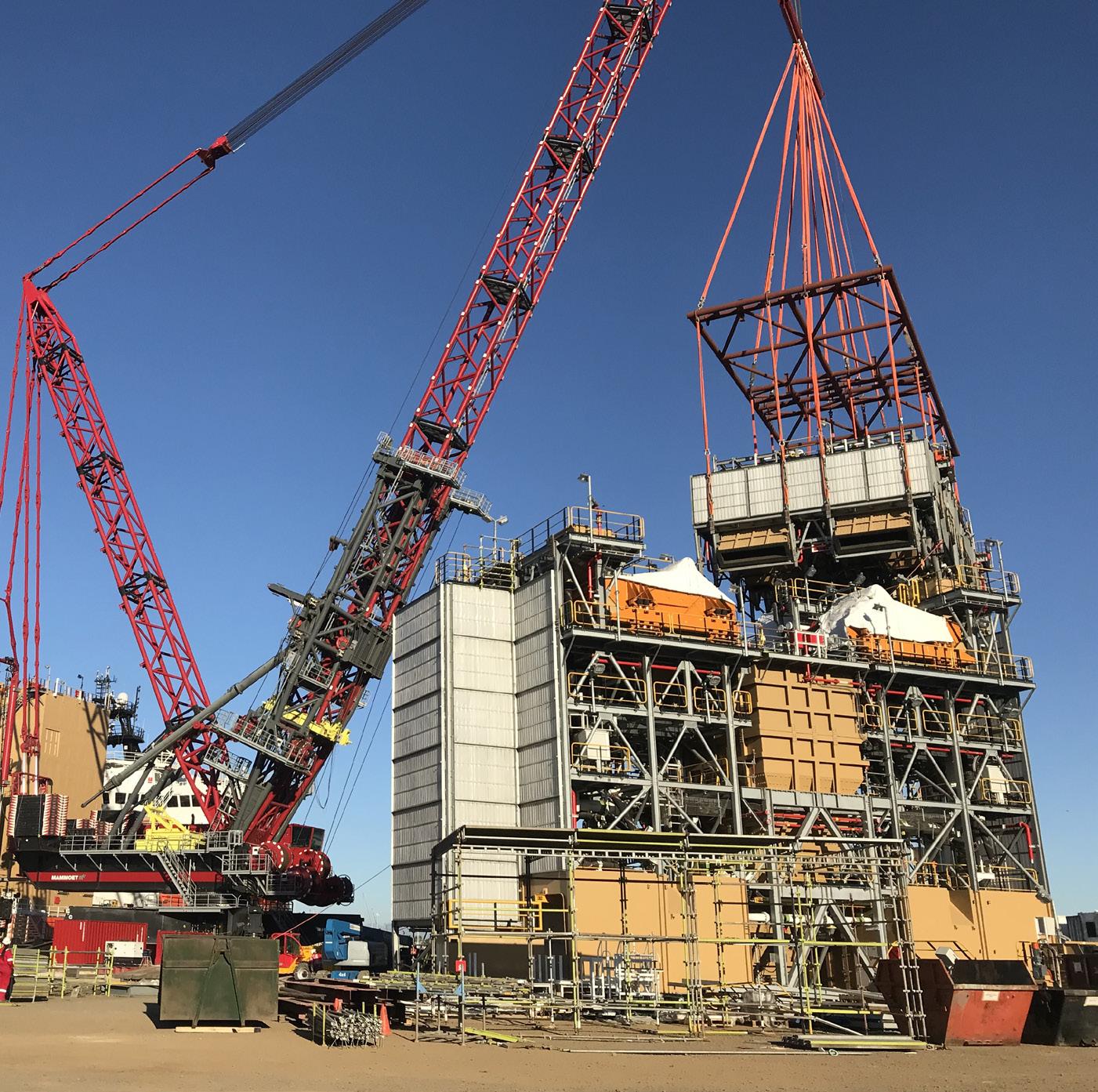
5 minute read
World’s most advanced diamond recovery vessel
Building a treatment plant on a custom-built diamond recovery vessel was never going to be the easiest of undertakings. Doing it in an award-winning fashion, however, is something to be proud of. Lifting Africa finds out more.
Much has been said of Debmarine Namibia’s (a 50/50 joint venture between the De Beers Group and the government of the Republic of Namibia) brand-new purpose-built ship, the MV Benguela Gem. The product of international collaboration, the ship was designed in Norway and Poland, built in Romania and fitted out by De Beers Marine South Africa. The vessel, which took two years to construct, is the most technically advanced diamond recovery vessel in the world, underpinned by high standards of sustainability and safety performance. The Benguela Gem is unique in Africa, being able to carry out the entire under-sea diamond dredging and treatment process. It arrived in South Africa in September 2021 with an empty deck, says Andre du Toit of PBA Projects, designers of the treatment plant on board the vessel. “PBA Projects was responsible for all elements of the processing plant, from the actual process design to mechanical equipment selection, electrical design, instrumentation selection, structural design, and shop detailing,” says Andre. “The structural design components covered the design of structures to withstand ships motions, vibratory equipment and reverse loading for the rigging of the fully fitted out structures onto the vessel.” The project was so impressive that it walked away as the overall winner at this year’s South African Institute of Steel Construction (SAISC) Annual Awards. According to SAISC CEO Amanuel Gebremeskel, a number of high-quality, truly excellent projects were showcased at the awards. “While there was tremendous merit across all of our entrants, as well as all our category winners,” enthuses Gebremeskel, “The SAISC
Advertisement


Annual Awards judges were unanimous in their praise of our overall winner - which was also the winner of the Western Cape and Mining categories - the Treatment Plant, on board the ‘Benguela Gem’, the world’s most advanced diamond recovery vessel.” The exceptional design, fabrication and installation of the 3000-ton diamond treatment plant on the vessel was carried out ahead of schedule by a team of local engineers and fabricators in the midst of Covid-19 pandemic restrictions. Says Gebremeskel, “This project stood out in a number of different ways, and presented a first in the history of the Steel Awards: it operates off-shore and is floating rather than being stationary and anchored - a truly distinctive applicant within the Awards categories. As a sea-faring structure, it is furthermore subject to unusual engineering loads from a naval engineering perspective.”
Building the plant
The Treatment Plant is on board the central section of the ship that is 177m long and 27m wide. According to Emma Loubser of PBA, the Mammoet FOCUS30 was used to lift the structures onto the vessel. “This crane has a 2500t lifting capacity and an incredibly small footprint. The crane can operate in very constricted spaces which were perfectly suited to this application as space on the quayside between the structures was very limited.” Working in such close confines the entire project required close collaboration between all the role-players. “The mass of the overall treatment plant components, combined, weighed in at just under 3000 tons. Each structural lift weighed between 50 and 428 tons,” says Emma. It was important that the plant be designed so that its structures could withstand reverse loading during lifting as well as all the custom lifting attachments to the treatment plant modules. “PBA also designed the lifting frames that were used to reduce loading in the structures during lifting,” says Emma. “The planning of the lifts was done in close collaboration with Mammoet and De Beers Marine.”

Dealing with the challenges
One of the biggest challenges facing the team was the space constraints on land. Lifting onto the vessel was not easy requiring a lot of careful planning. “Everything from where the modules were constructed on the quayside to accommodate the crane reach, to needing to lift over or around other structures, as well as considering the floating vessel and its orientation while structures were loaded had to be taken into account the entire time,” says Andre. “There were extremely small tolerances lifting onto the vessel for alignment to the correct landing locations, and as more and more structures were loaded the space on the vessel became increasingly smaller. The last structural lift onto the Benguela Gem was required to fit between 3 other structures with clearances of as little as 20mm, and thanks to the brilliant Mammoet team, and careful planning, it was executed perfectly.” Another big challenge was time. “The FOCUS30 crane is one of a kind in the world. The crane had been shipped to South Africa from Europe specifically for this job and had a strict end date to leave for North America for its next assignment.” In an effort to deal with these challenges, the team returned to the drawing board. “Where there were previously 16 smaller structural modules that had been designed to be lifted individually onto the vessel, these were revised to 9 super lifts,” explains Emma. Also, the lifting design aspects needed to be reexamined and special lifting frames designed to help reduce loading in the structures due to the revised super lift methodology. “Because of the super lifts and high loads, special rigging equipment needed to be sourced from around the world to make the lifts possible. These included 25t turnbuckles, 55t high strength shackles and 80t slings.” Thanks to the FOCUS30 and the structural re-design from a lifting perspective, the vessel sailed out of Cape Town only three months after it arrived in December 2021 with a fully operational mine onboard.
Celebrating excellence
The SAISC award, says Andre, has shed light on an exceptional area of extreme world-class engineering that is happening right here in South Africa. “The PBA Projects team is used to working in such a unique environment, but it is not necessarily common knowledge that such a level of design is happening here in Cape Town all the time, and the SAISC award has made this more accessible and given greater awareness to the broader engineering communities in South Africa and worldwide by showcasing this one-of-a-kind Project,” concludes Andre.











